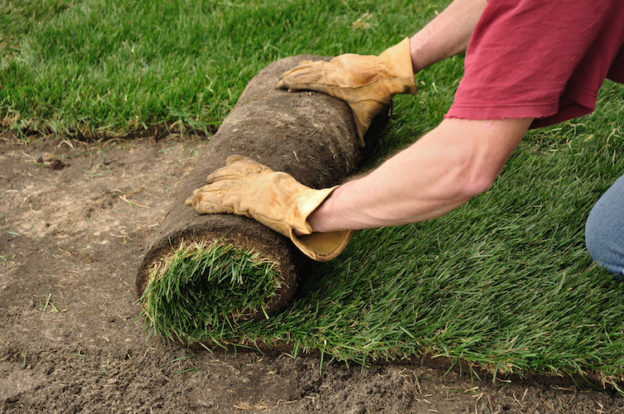Autumn is not only the best time of year to add new plants to the garden, it is also the ideal time to lay turf. To ensure you have success, follow our simple step by step guide on how to lay turf.
Prepare your space
Soil preparation is essential to success with any plant including grass. Remove all perennial weeds by hand or treat with a glyphosate weedkiller.
Next dig to a depth of 20-25cm (8-10 inches) and remove stones and other debris. You may find a rotivator easier for large areas.
When placing back the soil, dig in some well rotted manure to improve the structure for sandy soils or for heavy clay soils, you should add sharp sand, available from our garden centre.
TOP TIP: When digging, work backwards so you don’t tread down the soil you’ve just broken up.
Leave the area to settle, ideally for five to six weeks to ensure all weeds are removed but at a minimum for a few days. During this time, measure up the area and calculate how large your area is (length x width). Our turf rolls cover approximately one square metre.
Back outside, ensure you have a level surface, tread or roll the area several times. If you don’t think you have a good enough layer of topsoil, buy and apply a 2-6 inch layer (5-15cm). Rake this top surface.
Selecting your turf
We sell seeded turf in our garden centres. It is cultivated on a sandy loam soil which enables us to offer a consistent grade all year round, almost regardless of weather conditions. The following seed mixture is typical but can vary as it is constantly reviewed in an effort to produce the optimum quality of turf by our supplier:
· 25% Dwarf Perennial Ryegrass
· 35% Strong Creeping Red Fescue
· 25% Slender Creeping Red Fescue
· 15% Chewings Fescue
This mixture produces a turf which is fine enough for a stunning domestic lawn, has excellent wear tolerance yet at the same time is easy to care for. It is also used extensively for golf tees and amenity areas which are subject to wear.
We always receive our order of turf on a Friday as we find most people have the time to lay turf at the weekend and it is always best to lay turf within 24 hours of receiving it. If you cannot do this, roll it out flat and water if necessary to avoid discolouration and weakening of the grass.
Laying turf
Start laying your turf along a straight edge and work forwards so you face bare soil. Curved and slanted lines require the turf to be cut to fit. You could use an old kitchen knife.
Place a plank or piece of board on the first roll to stand on and spread your weight, this avoids damaging the new grass. Then continue laying the turf rolls with staggered joints, like brick work, pushing them as close as possible. This helps to avoid the joins being noticeable. In warmer weather some shrinkage is normal after laying so these steps help to make the newly laid lawn look as good as possible. Where this happens the effect will disappear as the grass grows, or you can sprinkle some fine soil or sand into any gaps.
At the end of a row of turf where a piece is cut to fit, it is best to avoid finishing with a very small piece. If necessary cut the previous piece and use a longer strip to finish. Again this reduces the problems of shrinkage.
Aftercare of new turf
After laying turf avoid vigorous use to allow it a chance to put down its new roots. This will take 2 to 4 weeks depending on the time of year. It grows a lot slower in the winter. During that time only walk very carefully on it, do not mow it and make sure it has plenty of water. It is easy to underwater but difficult to over water.
Once you can no longer lift up the corner of a turf, it has grown in and can be cut. The general rule is only ever cut off one third of the length. So if it’s growing very fast you will need to be patient and take a few mows to get it down to the length you want it. Leave 7 days between each cut. By doing this you’ll avoid the grass looking yellow.
TOP TIP: By planting in September onwards it is unlikely you will need to give the turf a cut this year. This is good for the turf as it gives optimum time to settle without stress.
Annually
Our turf suppliers treat with fertilisers and nutrients to make the turf healthy. To keep your lawn at its best we recommend a weed and feed type treatment each spring and autumn, available from our garden centres.
Leatherjackets, which are the young larvae of cranefly or daddy long legs, can also be a problem. we sell nematodes as an organic solution (there is no chemical one anymore). The nematodes are live worms, which get posted to you. Scatter the nematodes on the soil of infected area during the autumn. They eat the leatherjackets.
Finally we recommend aerating your lawn at least once a year to avoid soil compaction and helps the roots grow deeply thus producing a stronger more vigorous lawn.







